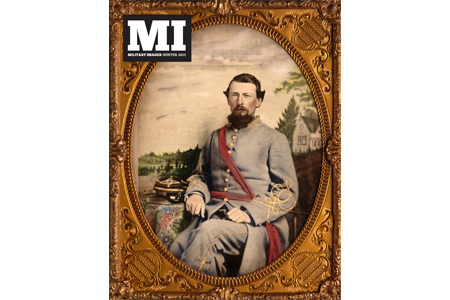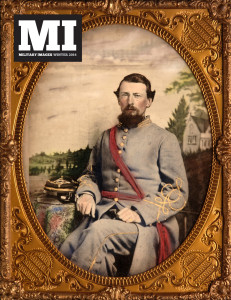The complete issue
Vol. XXXII, No. 1
(44 pages)
Print edition: Visit our store to check availability
Digital edition: Visit JSTOR.org to purchase
Subscribe to MI
Explore the MI Archives: Browse | Advanced search | Tutorial
Inside
Cover image
The hand-tinted image is a half plate ambrotype of Capt. James A. Holeman, Company A, 24th North Carolina Infantry, who was wounded at the Battle of Drewry’s Bluff and captured at the Battle of Five Forks.
Table of Contents (p. 1)
Editor’s Desk (p. 2)
This “Change in Command” issue features a farewell from David Neville, who introduces Ronald S. Coddington as the new editor and publisher of Military Images and thanks the “collectors and historians who contribute the wonderful photographs that grace the pages of each issue.” The incoming editor, Ronald S. Coddington, follows with a pledge to continue in the established tradition of MI and thanks subscribers for their participation in the recent survey and their valuable input, which have provided guidance for future publication changes.
Tar Heels! A Survey of North Carolinians in the Confederate Army by Greg Mast (pp. 3-12)
This Military Images feature article is an exclusive preview of Greg Mast’s recently discovered photographs of identified North Carolina citizen soldiers in advance of his second published volume of Tar Heel images. The article includes seven images detailed with individual biographies, unit histories, and descriptions of uniforms and weaponry. One very intriguing image is a possible self-portrait of “photographic artist” Capt. Abner David Peace of the “Granville Targeteers” 23rd Regiment North Carolina Troops, who saw service in a wide variety of battles. Another subject of the article is Pvt. Josephus S. Morris of “Tecumseh’s Scouts” 67th Regiment North Carolina Troops who saw duty only within North Carolina. The article’s seven subjects provide insight into the wide range of duty, background, and experiences that represent the soldiers known as Tar Heels.
Passing in Review by Ronald S. Coddington (p. 13)
The review is of Confederate Faces in Color by Shannon Prichard and Shane Kisner, a new volume that features over 300 color images of Southern soldiers, including the image of Capt. James A. Holeman, featured on the cover of this issue of Military Images.
“God Bless Gallant Old North Carolina” (pp. 14-15)
The quotation by Gen. Robert E. Lee referencing the arrival of North Carolina troops during the fighting at Appomattox, this article features five images of four North Carolina soldiers from the Liljenquist Family collection at the Library of Congress. One image has now been identified as a result of conversation on the MI Facebook page.
An Album of the Faces of the 25th USCT by Shayne Davidson (pp. 16-18)
Eighteen different gem sized tintypes of African American infantrymen serving in Company G of the 25th U.S. Colored Troops are the focus of this fascinating article. The images were originally owed by the Capt. William A. Prickett, who was nursed back to health by some of his soldiers. Capt. Prickett’s image is also included with the article. The author of the article created life-sized drawings of the men and entitled her noted 2013exhibit “Civil War Soldiers.”
Uniforms & History by Michael J. McAfee (pp. 19-23)
Fourteen images and two illustrations accompany “The Uniform Coat, Part 2: Enlisted Men” and its extensive discussion of the evolution of the 1858 frock coat for enlisted soldiers. The article discusses different variations used by state militia as well as variations in trimmings and buttons, including two features that are often not included in current reproductions of the frock.
Showdown With the Sioux by Scott Valentine (pp. 24-25)
The career of Irish immigrant, Capt. Ferdinand Edwin DeCourcy is described. DeCourcy arrived in the United States in 1857, and joined the army. He became a second lieutenant in May, 1861, with the 13th Infantry and saw action at Vicksburg. The article moves next to DeCourcy’s post-Civil War career, and begins by describing the extremes of the natural environment found on the Plains. However the focus of the article is on the defense led by DeCourcy and his soldiers against a stirring attack by Sioux Indians on Fort Cooke, Montana Territory, in 1868.
A Portrait of Lee We Were Not Supposed to See by Donald A. Hopkins (pp. 26-29)
The author challenges the generally accepted fact that two formerly known post-war images of Gen. Robert E. Lee attributed to the studio of John C. Boude and Michael Miley in Lexington, VA. Hopkins discusses the history behind a very rare image of Lee taken by C.R. Rees of Richmond. Lee had requested that Rees destroy the negative as he thought it “makes me look more like a prosperous Southern gentleman than a defeated warrior.” Rees ignored the request and the result is a fascinating single portrait with a rich history taken between November 25 and December 6, 1867. Hopkins’ discussion of the portraits’ verso documentation provides evidence that all three images were taken during the same sitting in Richmond in late 1867.
Four Decades on the High Seas: Boatswain William Long, An Englishman in the U.S. Navy by Ron Field (pp. 30-31)
The author provides an extensive history of the subject of a carte de visite of Boatswain William Long, probably taken in 1864. Long had many adventures at sea, including service as boatswain aboard the San Jacinto, which was noted for its many captures of Confederate blockade runners.
Stragglers (pp. 32-42)
Includes a wide variety of citizen soldiers through 22 different images from both the Civil War and Spanish-American War eras. A few of the unique images include a ninth-plate ambrotype of a Stonewall Brigade soldier in a case with a later newspaper clipping describing some of his service, a sixth-plate ambrotype of a Native American sharpshooter from Michigan, and a carte de visite of a Union soldier and four ladies, some of whom are dressed in military inspired clothing from the 1864 Army Relief Fair in Albany, NY.
The Last Shot (p. 44)
The ninth-plate ambrotype is of a very intense15-year-old Tar Heel, Pvt. James T. Rogers. He is shown armed with two different pistols. He enlisted with Company H of the 13th North Carolina Infantry in May of 1861 and served until discharged due to his age in August 1962. His unit was present during the Seven Days Battles.


